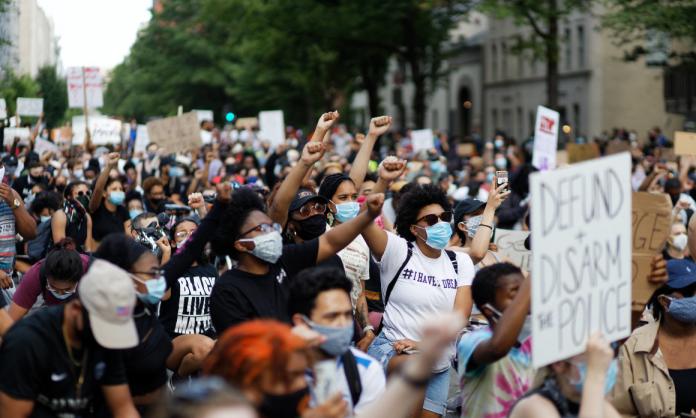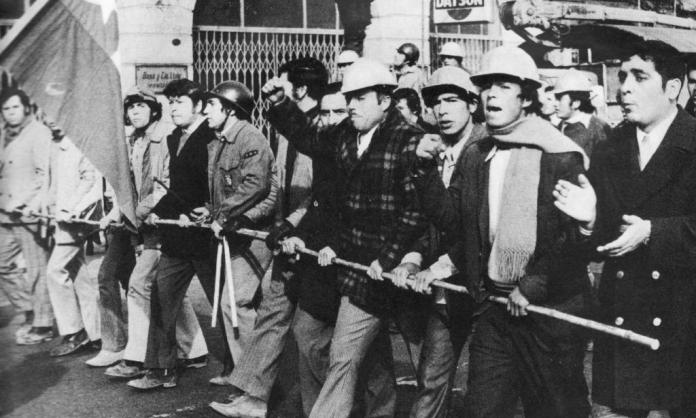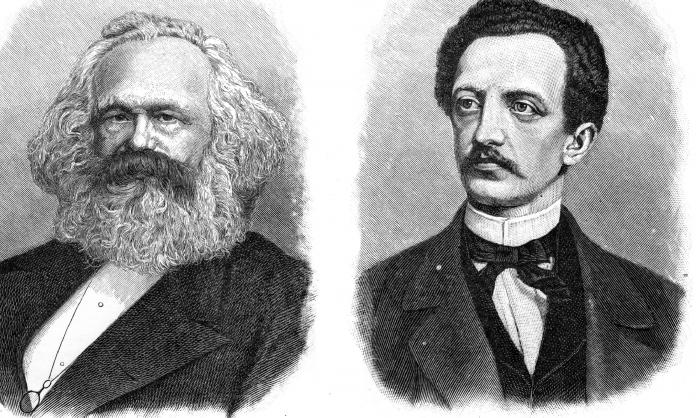The international working-class movement has long been divided between two strategies to win socialism: the reformist and the revolutionary.
Those advocating reform have argued that workers’ parties must win a parliamentary majority, pass legislation to improve the lot of the working class and, bit by bit, wrest power from the capitalist class. This was the project of social democracy in the early twentieth century, when it emerged as a mass force in European politics.
Revolutionaries, by contrast, argued that workers’ parties must overthrow the capitalist state and institute socialism from below, with insurgent workers establishing their own democratic institutions to run society.
Social democracy has shifted far to the right since these early debates. Very few social democrats today say their objective is socialism. Just look at Keir Starmer in Britain or, of course, Anthony Albanese here.
But it is nevertheless quite likely that when the class struggle begins to heat up, left reformist currents will emerge. So the debate is still relevant, and it is therefore necessary to understand what defines the two currents, and what divides them.
To start with reformists: a key feature of reformists is that they venerate the state, with parliament as its highest expression. They also see the state as a neutral body that can be captured by the progressive left. Both of these concepts are profoundly misguided.
The state is not neutral and parliament is not the controlling institution reformists imagine it to be: several elements of the state apparatus are far more powerful than parliament and repeatedly frustrate democracy.
The state is a coercive institution, and its purpose is to enforce the rule of one class over others. It monopolises the means of organised violence—the police, the army, the courts and the jails—to secure the domination of the ruling class. Capitalist states depend on the ongoing flow of profits to finance these bodies. This is why politicians elected to government very quickly come to understand that protecting the economy is one of their fundamental responsibilities. And “protecting the economy”, necessarily means protecting profits.
And then there are all the arms of the state that loyally serve the capitalist class.
The armed forces, far from “defending the nation”, defend the interests of those with money. Just look at the dispossession of the Indigenous population to serve the interests of the wealthy squatters.
The police’s main role is to protect the property of the rich. If you doubt that, look at the way they respond to picket lines and demonstrations—by making sure they have little to no impact on business as usual, through brutal force if necessary.
The courts also serve the interests of the capitalists. Workers who steal from their boss can be thrown into prison, while bosses who systematically steal from their workers are, at best, given a slap on the wrist.
Even departments of the state that seem aloof from repressive functions work in favour of capital. Welfare, immigration, education and health departments are all geared to ensuring that capitalists are provided with a suitable supply of healthy and literate labour. Welfare bureaucracies, which are meant to look after those in need, just as commonly harass the poor, with the criminal robodebt program being a recent example.
These departments operate just like any capitalist enterprise, with a small minority of highly paid bosses overseeing a big majority of low-paid workers.
This doesn’t mean that the state is merely a puppet of the capitalists. It does enjoy some autonomy, and there can be tensions at times between it and the capitalists. These can arise from the fact that the state has to balance the interests of capitalists competing against each other, the better to do what is best for Australian capitalism as a whole. And occasionally, if the working class is demanding reforms through strikes and riots, the state can be forced to make concessions in order to defuse the conflict and stabilise the system in the long term.
So the state is not a mere puppet, but it does work intimately with and within the capitalist class and in its interests.
Can the state be reformed then, given all that? Only in an extremely limited way. It certainly cannot be simply moulded by parliamentary legislation to suit working-class interests.
For a start, the most important elements of the capitalist state are unelected—the judges, the public service bureaucrats, the generals and the police commissioners. Any government that tried to sack these figures and replace them with left-wing generals or police commissioners would immediately face ferocious opposition. The High Court could be relied upon to block any overhaul of the state apparatus because its job is to defend the constitution, which is the constitution of property owners. And any attempt to purge the generals or police commanders would lead to a revolt within the army and police force and a refusal to cooperate.
Parliamentary elections are also not a neutral battleground. It’s true that every worker has one vote, the same as Twiggy Forrest or Gina Rinehart, but the way parliamentary elections are organised only muffles workers’ class demands. Workers turn up to the polling booth as millions of scattered individuals. They are subjected to intense media and corporate campaigns urging them to support conservative candidates and turn their backs on radicals. And so, while parliament is meant to represent the voice of the people, in practice it only provides democratic legitimation for the rule of the capitalists.
And even when sincere reformist politicians do manage to get elected, they face insistent right-wing media pressure day after day, while workers get a chance to vote only every three or four years. Besides which, the spoils of office are very enticing. The result is that the vast majority of radical politicians who have gone into parliament have capitulated and become loyal defenders of the status quo. It is they who are reformed more often than not, rather than the state. The rare minority who have not given in to these pressures are either expelled or relegated to the margins of the party as eccentrics.
These are all important obstacles to any reforming government. But, even without these problems, simply passing reforms in parliament is not enough to create socialism. At best, we would have a more generous welfare state, more public ownership.
It would still be a capitalist economy and a capitalist state. Workers would still be exploited and alienated from any control over the running of their workplaces and society. And its control of industry gives the capitalist class ample means to undermine and even destroy any government it disapproves of. The likes of James Packer and Frank Lowy are not, after all, going to sit back and allow their property to be taken from them.
The capitalists can cause economic turmoil by pulling their money from the country, cancelling investment projects, shutting down businesses, throwing thousands out of work and hoarding supplies. In 2010, such threats by the mining sector destroyed the Rudd government’s proposed resources super profits tax, and contributed to his downfall. The first thing his replacement, Julia Gillard, did was to scrap the tax.
The capitalists can also work with the conservative parties to block supply of funds to the government in the upper house if they have a majority and with the security forces to cause trouble. They can mobilise support from the US government, the IMF and international capital. They can unleash big crowds of middle-class supporters in street demonstrations to intimidate the government. And their ultimate recourse is to team up with right-wing forces to launch a military coup or fascist takeover. Two Labor governments in Australia have been driven out of office by such measures.
The first was the NSW government led by Jack Lang, who was sacked by the state governor at the height of the Great Depression in 1932 after threatening to delay payment of interest on British loans.
The second was the Whitlam government, which was dismissed in 1975 by the governor-general. The dismissal was the final step in a year-long campaign of capitalist sabotage.
The conclusion drawn by the ALP from Whitlam’s sacking was that future Labor governments would have to become even more conservative.
This is obvious today with the Albanese government immediately abandoning pre-election promises to protect workers’ wages. They are now telling workers to expect years of wage cuts while still planning to carry through the Morrison government’s tax cuts for the rich.
So, if a reformist approach is a dead end, what about revolution? A revolution is needed for two simple reasons. First, because the ruling class is not going to peacefully give up power. It must be disarmed. Second, because only by going through the experience of revolution does the working class become fit to rule.
A socialist revolution is not a palace coup that changes a few figureheads, but a total reorganisation of society. It is the ultimate social leap—a period when the gradual accumulation of mass bitterness and anger of the oppressed bursts forth into a mass movement to overturn existing social relations and replace them with a new society.
In today’s world, that means a workers’ revolution to smash the capitalist state and begin the process of constructing socialism. As Leon Trotsky put it, revolution is “the forcible entrance of the masses into the realm of rulership over their own destiny”.
Revolutions are dramatic events. Rulers and systems that seemed invincible are suddenly unceremoniously toppled. To see how profound revolutions are, just think of the Arab revolutions of 2011, or the Sudanese revolution of 2019 or even the mass struggles in Sri Lanka in recent months, when longstanding dictators and leaders were toppled in a matter of a few days or weeks. And these were not even working-class revolutions. When workers seize power like they did in Russia in 1917, the whole of society is turned upside down.
That all sounds very dramatic. But it all seems a long way from where we are today, particularly in a wealthy country like Australia. It’s not surprising that most workers regard revolution as far-fetched most of the time.
It’s not just that the ruling class goes out of its way to ridicule the notion of revolution. It’s also that the ideas that encourage the passivity we see around us, and which make revolution such a remote idea, fit with our experience of capitalism: our lives are governed by forces that are seemingly beyond our control. So why would most people think things could be any different?
Yet at certain moments revolutionary upheavals and protest movements arise as if out of nowhere to challenge the logic of the system, and ideas of solidarity and collective struggle, rather than individual advancement, gain a hold over millions of people.
The system itself generates these upheavals. Capitalism regularly and dramatically transforms people’s lives through economic booms and busts, technological transformations, industrial revolutions and wars. Everything is in a constant state of disturbance.
Struggle between the capitalist and working classes is a necessary consequence of these changes. Such struggle is often of a fairly modest scale—a strike here, a demonstration there. But at times when the struggle starts to escalate beyond a single workplace or industry, or beyond a single partial demand, the class divisions in society start to open up. And when the class struggle is particularly intense, the long-term interests of the workers and capitalists can become apparent to large numbers of people.
Struggle, then, is crucial to transforming social reality and also the consciousness of the working class.
Workers on strike quickly learn which side the police, courts and media are on. The experience encourages solidarity and calls into question divisions of race, sex, sexual orientation, language and nationality that are deliberately fostered by the ruling class. It becomes clearer that if any part of the working class or oppressed is held down, it makes it easier for the bosses to hold all workers down.
Moreover, as workers organise on a wider scale, they begin to see that their interests lie not only in organising one workplace, or one industry, for the purposes of self-defence, but in taking wider control of society and challenging the power of the state. It becomes obvious that workers need to take in hand all the big decisions. Who will organise the provision of food? Of transport? Of health care? Of fuel and heating? Of security? What to do when the boss flees and tries to sabotage the factory rather than see it fall into the hands of the workers?
In such circumstances, workers have to take over. They are the only social class other than the capitalists capable of organising society as a whole. They keep society running and create what is needed through their activity, and because they do it collectively, they must organise democratically. They do this through the formation of committees—workers’ councils—on a city-wide or broader basis, linking representatives from every significant workplace and industry to work out answers to the problems confronted by the struggle. These then have to appeal to workers in other cities and regions, laying open the prospect of a national uprising.
In Russia the workers’ committees were called soviets, in Chile in 1973, cordones, and in Iran in 1979, shoras. Whatever name they go by, they amount to the same thing, the encroachment by popular organisations of the working class on the control hitherto in the hands of the bosses.
The ruling class of course don’t remain idle when their industries begin to fall under workers’ control. The question of the workers securing what they have won therefore quickly comes to the fore.
That means the need for self-defence, arms in the hands of the workers and, down the track, the formation of workers’ militias under the control of the workers’ committees, to repel attacks by the police, the bosses’ thugs and army. That also means workers appealing to rank-and-file soldiers to turn their guns on their officers by appealing to them on a class basis.
In this process, political leadership is crucial. A class used to passivity and deference must act quickly and decisively if it is to succeed against a well-organised enemy. It is not enough to hope this happens spontaneously or through luck. As many workers as possible, and especially those leading the struggle, need to be organised, have had prior experience of struggle and have thought in advance about what will be needed to win to maximise the chance of success. This is the purpose of a revolutionary party.
Without such an organisation, workers are much more likely to be defeated. You only have to compare the experience of Russia in 1917, where the quarter of a million strong Bolshevik Party led the working class to power, with that of other mass uprisings in the twentieth century that were defeated to see the importance of such a party.
While a successful revolution is the ultimate goal of revolutionaries, this doesn’t mean rejecting struggles for reforms and simply waiting for a revolution. In fact, revolutionaries fight most fiercely for reforms, whether that’s to raise the minimum wage, defeat anti-union laws, improve access to abortion or increase Newstart payments.
The difference lies in the way revolutionaries fight for reforms as opposed to reformists like the Labor Party and Greens.
First, in every campaign, revolutionaries want to push mass struggle to the forefront. When large numbers of people are involved, whether through striking or demonstrating or taking other sorts of action, it provides direct experience of fighting and, in the right circumstances, gives workers and the oppressed a sense of their own power. This gives such struggles the potential to escalate into broader challenges to the system or, short of that, provides important experience to workers for future struggles.
Mass involvement also makes it harder for politicians or governments to resolve things behind closed doors—so it increases the chances that real concessions can be forced from the powerful. That is, it is a more effective method for winning reforms than being hostage to benevolence or the electoral cycle.
This is not just some abstract debate. The differences between revolutionaries and reformists are important, even if they sometimes want (or claim they want) to fight for the same things in the here and now.
That’s obvious when you look at the Albanese government—for example its support for the fossil fuels industry or its tax cuts for the rich. Revolutionaries are adamantly against Labor’s agenda and want to organise students and workers to fight these attacks; reformists apologise for them because keeping Labor in power is the centrepiece of their political strategy.
This is even more the case when the struggle heats up. Revolutionaries and reformists find themselves on opposite sides of the barricades at these times because reformists turn viciously against the working class when capitalism is threatened. They form the last line of defence for the capitalist order.
That was what happened in Germany in 1918 when workers followed their Russian counterparts and overthrew their imperial government. Faced with the option of leading a revolutionary challenge to capitalism or defending the capitalist status quo, the million-strong German reformist party chose the latter. It took government with the blessing of the old state machine and proceeded to crush the workers’ councils that had sprung up. It sent right-wing army squads to shoot revolutionary workers. Six months of virtual civil war followed in which the social democrats saved capitalism in Germany, killing the revolutionary leaders as they did so.
So this question is not just some university debate. It has life or death consequences. Revolutionaries need to build our forces long before revolutionary upsurges; otherwise, the reformists will take charge and destroy the revolution. Today, that means being part of struggles and attempting to win more people to revolutionary politics through whatever means we can.











